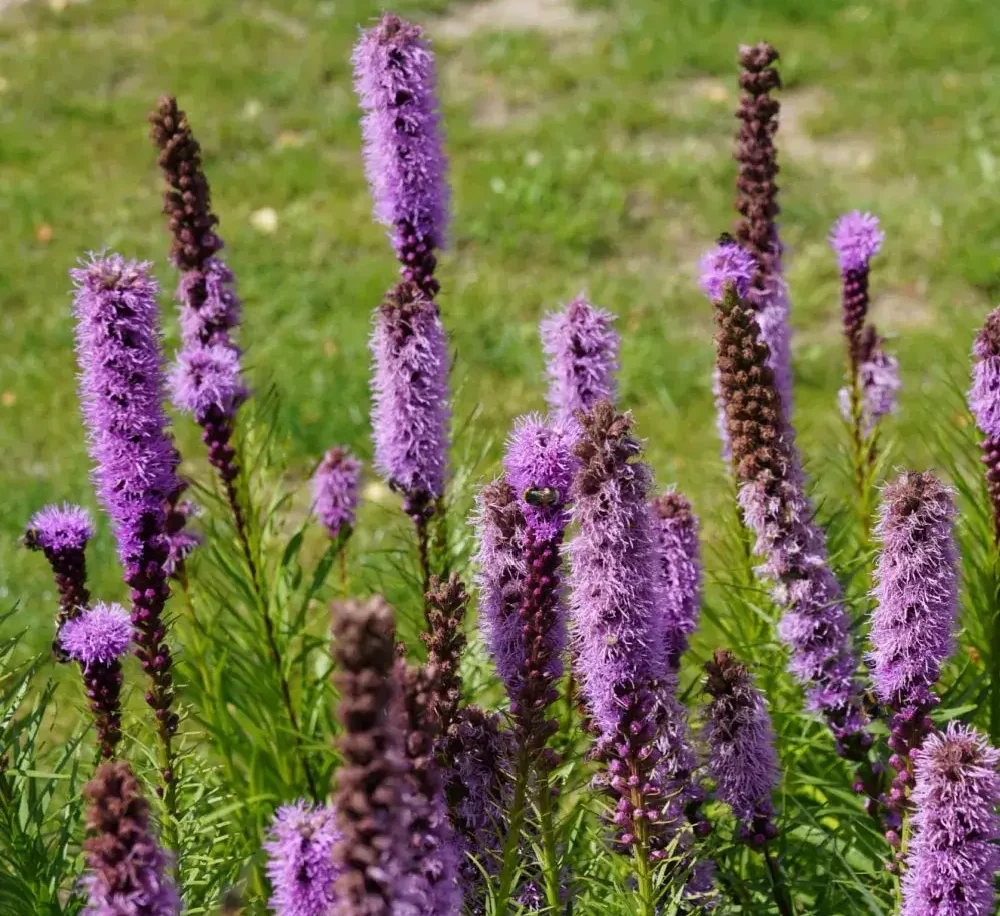Family: Blazing Star
Type: Perennial
Other Common Name: Dense Blazing Star, Marsh Gayfeather

Liatris spicata ‘Blazing Star’, commonly known as Blazing Star or Gayfeather, is a striking perennial known for its tall, spikey blooms. It’s a favorite for its vibrant purple flowers and statuesque appearance.
This perennial brings vertical interest and a pop of color to any garden setting. Its tall, dense flower spikes are a magnet for butterflies and bees, adding life and movement to the garden.
Thriving in full sun, Blazing Star is hardy in zones 3-9. It prefers well-draining soil and is drought-tolerant once established, making it a resilient choice for various garden conditions.
Hardiness Zone: 2b-3a
Deer Resistant: Yes
Pet Friendly: Yes
Moisture Preference: Dry to moist
Sun Needs: Full sun
Drought Tolerance (Xeriscape): Yes
Growth Rate: Fast
Average Height (feet): 5
Average Spread (feet): 1.5
Average Life Span (years): 10
Form: Towering
Flower Color: Purple
Secondary Flower Color: Pink
Bloom Season: From early to mid summer
Foliage Color: Green
Foliage Shape: Grassy
Incorporating Blazing Star into your garden design offers a dramatic display of height and color. Its tall flower spikes create an eye-catching focal point in any garden.
This plant is ideal for use in borders, wildflower gardens, and as a cut flower in bouquets. It’s particularly effective when planted in groups, creating a striking visual impact.
Despite its impressive appearance, Blazing Star is relatively low maintenance. It’s a great choice for gardeners looking for a long-blooming perennial that requires minimal care.

In cottage gardens, Blazing Star adds height and structure. Its natural, wildflower-like appearance fits perfectly in these informal settings.
For pollinator gardens, Blazing Star is an excellent choice. Its nectar-rich flowers attract butterflies, bees, and hummingbirds.
In contemporary gardens, Blazing Star's architectural form and bold color can be used to create striking patterns and contrasts.
Plant it in the back of borders for a vertical accent. Its height makes it an ideal backdrop for shorter plants.
Use it in a mass planting for a dramatic effect. Large groupings of Blazing Star create a sea of purple in the summer.
Combine it with other sun-loving perennials. Grasses, coneflowers, and black-eyed Susans make great companions.
Select our pre-made garden layouts to create a landscape that’s uniquely yours. Simple, smart, and customizable!
In spring, Blazing Star starts to grow its foliage, setting the stage for the blooms to come.
During summer, it blooms with tall, purple spikes, adding a vertical dimension and vibrant color to the garden.
In the fall, the flowers may fade, but the plant still adds structure to the garden as it prepares for dormancy.
In winter, Blazing Star dies back. This period of dormancy is essential for the plant's lifecycle and prepares it for blooming in the next season.
Blazing Star thrives in full sun areas, perfect for open, sunny borders, wildflower gardens, or any spot that receives a lot of daylight.
This perennial requires full sun to bloom profusely. At least six hours of direct sunlight each day is optimal for the healthiest growth and most vibrant flowers.
Blazing Star prefers well-draining soil and is adaptable to various soil types, though it thrives in slightly moist conditions.
Space Blazing Star plants about 12 to 18 inches apart. This spacing allows for mature growth and proper air circulation, which is vital for their tall spikes.
The best time to plant Blazing Star is in the spring or early fall, allowing the roots to establish before extreme weather.
Dig a hole as deep as the root ball and twice as wide. Place the plant in the hole, backfill with soil, and water thoroughly. Plant at the same depth it was in the container.
Regular watering is essential, especially during dry spells. The soil should be kept moist but not waterlogged.
Fertilize in early spring with a balanced, slow-release fertilizer to promote vigorous growth and abundant blooms.
Deadheading spent blooms can encourage more flowers. Cut back foliage in late fall or early winter after the plant dies back.
In spring, clear away any dead foliage, apply mulch to retain moisture, and start regular watering as new growth appears.
Continue watering and deadheading throughout the summer to maintain vibrant blooms and healthy foliage.
After the first frost, you can cut the plant back to the ground. This helps prepare it for winter dormancy.
Blazing Star is dormant in winter. Apply a layer of mulch for protection, especially in colder climates.
Blazing Star typically reaches heights of 2 to 4 feet, making it a striking addition to any garden.
Yes, Blazing Star is generally deer-resistant, making it a good choice for gardens in deer-prone areas.
Yes, Blazing Star can be divided every few years in early spring or fall to maintain vigor and control its spread.
Sign up below to get exclusive deals, discounts, and new plant collections—delivered straight to your inbox! Plus, stay inspired with the latest gardening tips, landscaping trends, and DIY garden ideas. Start growing with us today!
A big thank you for subscribing to the PBN Design newsletter.
We're thrilled to have you join our community. Get ready for exciting updates, insightful content, and more delivered straight to your inbox.
Stay tuned!
Go backA big thank you for subscribing to the PBN Design newsletter.
We're thrilled to have you join our community. Get ready for exciting updates, insightful content, and more delivered straight to your inbox.
Stay tuned!
Go back